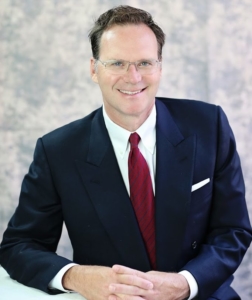Tyrone Callahan was uniquely positioned to take over the role of vice dean of undergraduate programs at the University of Southern California’s Marshall School of Business when he was tapped for job in the summer of 2014. He’d spent the previous six years in the management trenches at the Marshall School, learning the ins and outs of the four-year undergraduate business program, known for its innovative programming, flexible curriculum, and strong grounding in liberal arts.
Before taking on the helm as vice dean, Callahan served as academic director of the World Bachelor in Business program, a unique program that lets select Marshall undergraduates study at three different business schools around the world and earn a bachelor’s degree from each institution. Prior to that, he spent three years as academic director of the undergraduate business program at the Marshall School, part of a team that oversaw the most significant overhaul of the undergraduate business curriculum in the past 20 years.
“Those roles really let me see how the university works, and how the Marshall School reacts with the university,” says Callahan, a professor of clinical finance and business economics who’s been at the Marshall School for more than a decade. “The World Bachelor Program in particular touches on things like university processes, admissions, housing, and medical insurance. We had to make sure we considered every aspect of the program and what the student experience would be like. Through that I was able to learn a lot about how the university works in different capacities in a way that most faculty members are unaware of.”
FAMILIAR FACE WHO IS HANDS-ON, WITH OPEN-DOOR POLICY
It’s this insider’s view that has enabled Callahan to lead the Marshall School’s undergraduate program with confidence and determination, helping the top-ranked school crack the top 10 of the US News’ ranking of best undergraduate programs this past year. Many expect the school to continue its upward trajectory with the opening this fall of the Jill and Frank Fertitta Hall, a new building that will bring state-of-the-art classrooms and expanded student areas to the school’s undergraduate business population, which up until now has been dispersed amongst several different buildings.
Callahan is a familiar face to many students on campus, and describes himself as a hands-on dean with an open-door policy. He has monthly meetings with the leaders of the student organizations, hosts town hall meetings and likes to lunch with undergraduates. He’s a frequent guest lecturer in classes on campus, and every spring he accompanies a cohort of students on a trip to China.
Callahan recently spoke with Poets&Quants about the school’s flexible curriculum, how the new undergraduate building will change the student experience, and why Southern California is being dubbed “Silicon Beach.”
What is the undergraduate experience like for Marshall students, and how are they integrated with the rest of the university?
Our undergraduate students are business students but also USC undergraduates. We emphasize a lot of the liberal arts aspect of their education, and they have requirements in terms of general-education requirements. That means their experience is more of a whole USC experience, rather than exclusively a Marshall student the way it is for our graduate students.
When I was academic director, one of the first things I did was work with the then-vice dean of the undergraduate program on a more wholesale review and restructuring of the undergraduate curriculum. USC has for a long time emphasized what our former president calls “breadth with depth.” The idea is really for undergraduate students especially to really have as much depth as appropriate in their area of expertise. If you’re in a professional school like Marshall, that means you’ll know everything you need to know about business or finance or marketing, but combine that with a significant exposure to a field outside their core discipline.
The whole idea being that apart from a liberal arts education and the exposure you get through general education requirements, it is also useful at that stage of intellectual development to really understand there are important differences in the ways different fields approach problems and problem solving.
The university itself is set up to allow students a lot of mobility and flexibility in how they design their four-year undergraduate experience, so they can major or minor or double major and do all these things that really give them that opportunity for breadth of depth in their studies.
You were involved with the curriculum redesign six or seven years ago, and have helped implement it along the way. What are some of the long-term changes that resulted from this overhaul?
We have always only had two majors, a business major and an accounting major. The accounting major is necessary because of the specific CPA requirements, but within the business major we have not had separate majors for finance, marketing, operations, and other areas. What we used to have was what we referred to as concentrations, which were baskets of upper division electives that were thematically organized. For example, if you decided to concentrate in marketing, you could choose from eight upper-division electives and choose the four that would be required to give you a marketing concentration.
What we found was that students started to want to mix and match outside the structure of these “baskets” of classes. For example, somebody who wanted to go into investment banking might want to take a class on negotiations that they thought would be relevant for their careers, but was not in the bucket of classes related to investment banking. We’d have to sign a form that would allow them to substitute that class for another one. We found we were doing more and more of that, so we decided to do away with concentrations.












Questions about this article? Email us or leave a comment below.